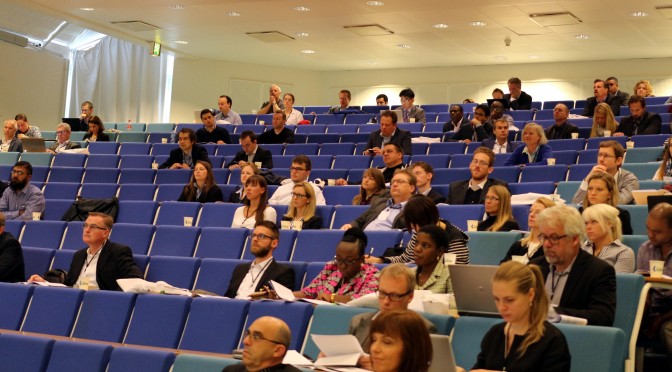In the middle of the second and last day of NOFOMA Conference at Himolde University College a plenary session was held. During which Associate prof. Amir Sasson currently operating at BI, Norwegian Business School , gave speech about the future of the industrial production and its impact on logistics. He believes that future belongs to 3D printers.
Photo by KRYSTOF DIATKA
The presentation begun with definition of what future industrial production companies are going to be based upon. Associate Prof. Amir Sasson believes that it is going to be knowledge and environmental robustness. The placement of such companies was then elaborated and it was postulated that the desired location of such companies needs to fulfill requirements such as cluster attractiveness, talent attractiveness and ownership attractiveness.
Associagte Prof. Amir Sasson compares bidding process of cities and towns for placement of those factories to a “Beauty contest” which needs to be considered by local political and governmental bodies. The small-scale size of these areas is not necessarily a disadvantage if they fulfill earlier mentioned requirements. This is enabled by rapidly developing technology of 3D printing.
The 3D printing on a rise reveals the possibility to produce all sorts of goods such as car parts, clothing, weaponry but even houses or artificial organs. It is possible to use a whole variety of materials.

This technology allows producers with sufficient hardware and software background to produce large and small lot sizes with relatively same overhead expenses and with the requirement of only pure raw materials.
Assuming this plan would be put into action the current concept of Global production and global to local logistics could be shifted to local regional production with the requirement of producing and shipping only raw material globally. Naturally the logistic challenges connected with this system would be enourmously less complicated.
Both consumers and producers call very strongly for environmental responsibility and sustainability of industry these days. Acording to the presentation the 3D printing fits those needs perfectly since raw materials used in the production process could be easily recycled and reused in the same way for a different product.
The impact of this development on logistics could be summed up in a statement given during the speech that the importance of containers in transportation would drop by 90% since trucks would be enough to distribute goods locally.
The overwhelming question whether the consumers would be able to print out their own goods on a “desktop” 3D printers at homes was addressed by Associate Prof. Amir Sasson.” Even though we all own desktop printers we still do not print our books on it. We buy them in a store instead. Same development could be expected in the world of 3D printing. The quality of cheaper home 3D printers is naturally inferior to the industrial ones.”

